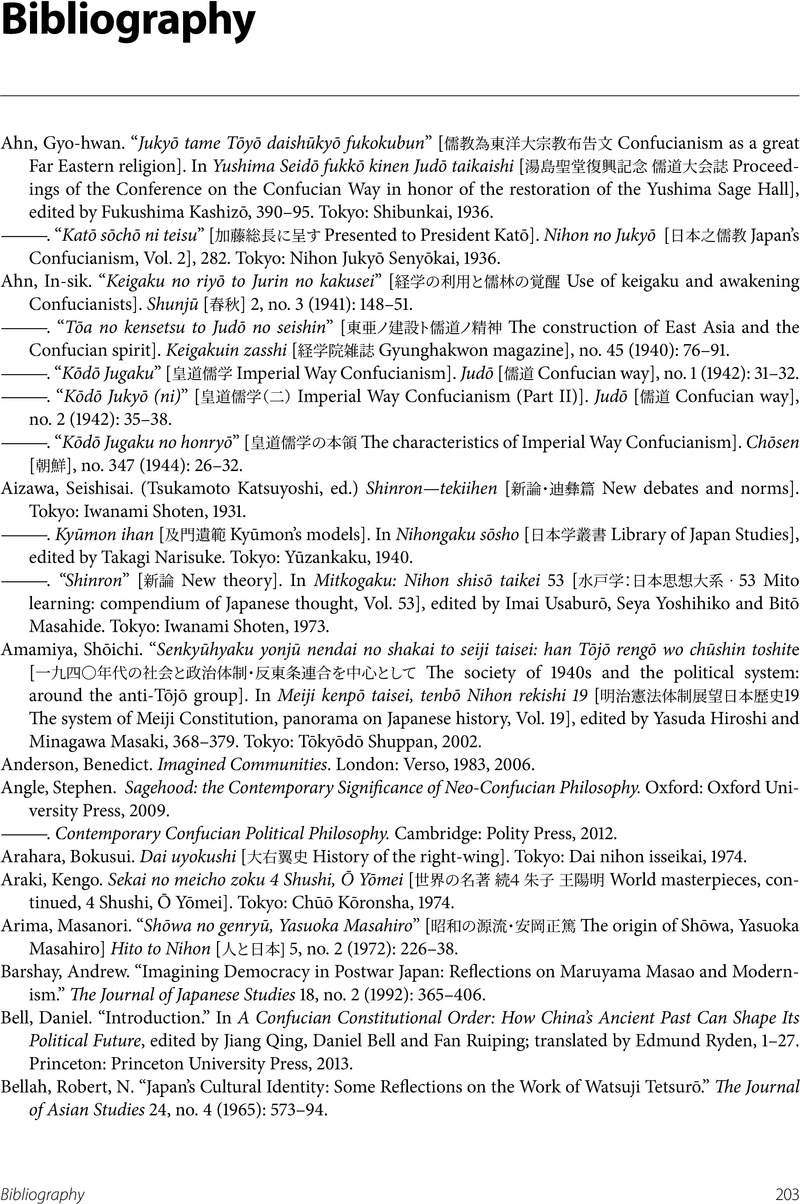Book contents
- Frontmatter
- Miscellaneous Frontmatter
- Table of Contents
- Contributors
- Preface
- Introduction
- Chapter 1 Reinterpreting Matsumiya Kanzan: On the Interval between State Shintō and the Idea of the Three Religions
- Chapter 2 The Confucian Classics in the Political Thought of Sakuma Shōzan
- Chapter 3 The Confucian Traits Featuring in the Meiroku Zasshi
- Chapter 4 The Invention of “Chinese Philosophy”: How Did the Classics Take Root in Japan’s First Modern University?
- Chapter 5 Inoue Tetsujirō and Modern Yangming Learning in Japan
- Chapter 6 Kokumin Dōtoku for Women: Shimoda Utako in the Taishō Era
- Chapter 7 Modern Contextual Turns from “The Kingly Way” to “The Imperial Way”
- Chapter 8 The Discourse on Imperial Way Confucian Thought: The Link between Daitō Bunka Gakuin and Chosŏn Gyunghakwon
- Chapter 9 The Image of the Kingly Way during the War: Focusing on Takada Shinji’s Imperial Way Discourse
- Chapter 10 Watsuji Tetsurō’s Confucian Bonds: From Totalitarianism to New Confucianism
- Chapter 11 Thinking about Confucianism and Modernity in the Early Postwar Period: Watsuji Tetsurō’s The History of Ethical Thought in Japan
- Chapter 12 Yasuoka Masahiro and the Survival of Confucianism in Postwar Japan, 1945–1983
- Chapter 13 Universalizing “Kingly Way” Confucianism: A Japanese Legacy and Chinese Future?
- Bibliography
- Glossary
- Index
Bibliography
Published online by Cambridge University Press: 31 May 2023
- Frontmatter
- Miscellaneous Frontmatter
- Table of Contents
- Contributors
- Preface
- Introduction
- Chapter 1 Reinterpreting Matsumiya Kanzan: On the Interval between State Shintō and the Idea of the Three Religions
- Chapter 2 The Confucian Classics in the Political Thought of Sakuma Shōzan
- Chapter 3 The Confucian Traits Featuring in the Meiroku Zasshi
- Chapter 4 The Invention of “Chinese Philosophy”: How Did the Classics Take Root in Japan’s First Modern University?
- Chapter 5 Inoue Tetsujirō and Modern Yangming Learning in Japan
- Chapter 6 Kokumin Dōtoku for Women: Shimoda Utako in the Taishō Era
- Chapter 7 Modern Contextual Turns from “The Kingly Way” to “The Imperial Way”
- Chapter 8 The Discourse on Imperial Way Confucian Thought: The Link between Daitō Bunka Gakuin and Chosŏn Gyunghakwon
- Chapter 9 The Image of the Kingly Way during the War: Focusing on Takada Shinji’s Imperial Way Discourse
- Chapter 10 Watsuji Tetsurō’s Confucian Bonds: From Totalitarianism to New Confucianism
- Chapter 11 Thinking about Confucianism and Modernity in the Early Postwar Period: Watsuji Tetsurō’s The History of Ethical Thought in Japan
- Chapter 12 Yasuoka Masahiro and the Survival of Confucianism in Postwar Japan, 1945–1983
- Chapter 13 Universalizing “Kingly Way” Confucianism: A Japanese Legacy and Chinese Future?
- Bibliography
- Glossary
- Index
Summary

- Type
- Chapter
- Information
- Handbook of Confucianism in Modern Japan , pp. 203 - 224Publisher: Amsterdam University PressPrint publication year: 2022

